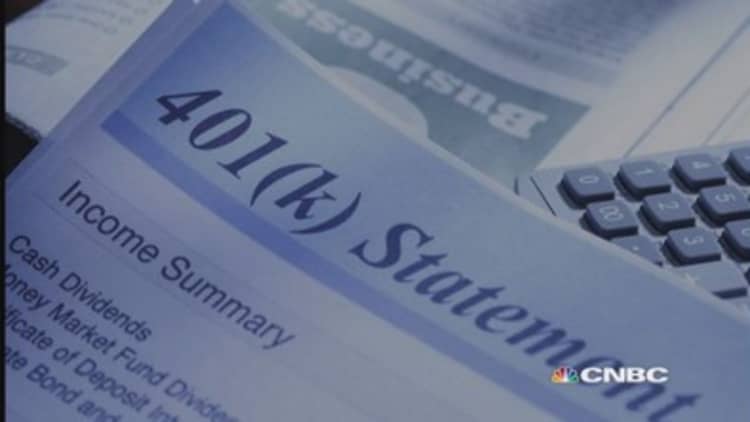


Despite the challenges many Americans face in setting aside enough money to finance their golden years, experts say the retirement system is not a lost cause. But a few improvements—many already in the works—could make a big difference for savers.
It's not surprising that retirement—specifically, not having enough money to retire—is Americans' top financial concern, according to a 2014 Gallup poll. As the burden of saving for retirement has shifted from employers to workers, many are falling short. At the end of 2013, the median 401(k) account balance was just $18,433, according to the Employee Benefit Research Institute. Fees are eating into those meager balances—to the tune of as much as $17 billion a year, according to a recent report from the White House. Then after retirement, there's little guidance for savers to determine how to draw down accounts to stretch that nest egg.
"A do-it-yourself retirement system isn't any more feasible than a do-it-yourself health-care system," said Monique Morrissey, an economist with the liberal Economic Policy Institute specializing in retirement security. "People need to be guided."
Read More For millions of Americans, 401(k) plans have fallen short
Even those workers expecting a pension may not be in the clear. Pension obligations have outpaced funding in many plans. A recent CNBC analysis of financial data for 150 state and local pension plans found that only six were fully funded. Last year, Congress also eased rules allowing multi-employer pension plans to cut participants' benefits, after the government's Pension Benefit Guaranty Corporation estimated its program bailing out failed plans of that kind had a 90 percent chance of being exhausted by 2032.
"It sets a dangerous precedent," said Karen Friedman, executive vice president and policy director for the Pension Rights Center.
Then there's Social Security. Younger workers are losing confidence that the program will help them in retirement, and with good reason. The 2014 Social Security and Medicare Boards of Trustees report estimates that if Congress does not act, Social Security's trust funds will be depleted by 2033. After that, Social Security Administration income from payroll taxes will only be enough to cover three-quarters of the benefits promised retirees.
Read More Funding shortfalls put pensions in peril
But it's not all doom and gloom. A recent study from the Center for Retirement Research at Boston College estimated that only about 12 percent of households approaching retirement might be falling short, provided they spend less once their children leave home and their household spending declines in retirement.
Industry groups, such as the Investment Company Institute, have called the retirement system "an American success story," noting that more than 80 percent of workers with access to retirement plans participate in them and those approaching retirement have an average combined balance of nearly $360,000 in their employer-sponsored retirement plans and IRAs.
"The U.S. retirement system—made up of Social Security, 401(k) plans, pensions, IRAs and homeownership—is strong and working for the vast majority of Americans," an institute spokesperson said. "Any changes should build on the system's successes by expanding access to savings opportunities for employers and workers."
Improving the system doesn't come down to one specific action or strategy. "We look at the policy picture in two buckets," said the Pension Rights Center's Friedman. "One bucket is protecting people already in the system, and the other bucket is, how do we expand the retirement system to cover more people?"
Consumers must also change their behavior to better plan and prepare for the reality of the current retirement system. "The whole reason we're talking about it is that people are not all-knowing and all-rational," said Morrissey. "We don't teach this in school. It's a huge, huge shift."
Broadening access to retirement accounts would go a long way to improving retirement prospects for Americans, said economist Teresa Ghilarducci, director of the Schwartz Center for Economic Policy Analysis at The New School in New York City. Just 49 percent of all workers have access to a retirement savings plan at work, according to the Employee Benefit Research Institute.
"The problem here is not that people don't want to save," Ghilarducci said. "The problem is that people don't have the appropriate vehicles in which to save." Sure, workers without access could open an IRA, but the $5,500 annual contribution cap is less than a third of the $18,000 someone could stash this year in employer-sponsored accounts such as a 401(k) or the government's Thrift Savings Plan (or a difference of $6,500 versus $24,000 if they're 50 years or older).
Nor do IRAs have the advantage of an employer match, she said.
Read MoreHow much are you paying in 401(k) fees? You'd be surprised
Policymakers have begun making strides in that area. MyRA accounts, first proposed by President Barack Obama in his 2014 State of the Union address, offer a Treasury-backed investment for low-income earners who don't have access to a plan at work. Several states, including Connecticut, Illinois, Maryland, Massachusetts and Oregon, are offering or developing state-run retirement savings plans for some private-sector workers.
The 401(k) rules should also be altered to both increase participation and stem "leakages," said Alicia Munnell, the Center for Retirement Research director and co-author of "Falling Short: The Coming Retirement Crisis and What to Do About It." "This needs to work more like a system of saving for retirement, rather than everyday savings," she said.
More employers are automatically enrolling employees in their plans unless they opt out and offering automatic escalating contribution options, so that employees can select to increase contributions by a set percentage automatically each year until they cap out. Both measures are necessary, said Munnell. "Otherwise you put people in at 3 percent and they just kind of stay there," she said. (Many of the state initiatives include auto-enrollment for IRAs, and Obama has pushed for a federal auto-IRA.)
Read MoreWhy post-retirement planning is harder than ever
Rules also could be more restrictive on allowing employees to cash out their accounts when they move from one job to another. "That should be prohibited," Munnell said. Hardship withdrawals might also be disallowed for predictable expenses like education or a home purchase, she said, and the 10 percent early withdrawal penalty eliminated in true hardship situations. (the American Institute of Certified Public Accountants issued a series of recommendations to the Senate Finance Committee Tax Reform Working Group on Savings and Investment on Thursday, including creating uniform rules for early withdrawal penalties.)
Tax benefits for retirement savings could also be reassessed. "Our tax subsidies for retirement savings right now are upside down," said Morrissey. Savings from pretax contributions are more valuable for workers in higher tax brackets, said Ghilarducci. "If you make $20,000 and save $1,000, that's not as big of a break," she said.
Groups including the National Institute on Retirement Security have recommended making the existing Retirement Savers Credit refundable and expanding its eligibility. Currently, it offers low-income workers a credit of 50 percent of retirement contributions, worth up to $1,000.
Read MoreMaximizing your Social Security benefits
Stronger regulations are also needed to protect savers, said Arkansas-based certified financial planner Sheryl Garrett, founder of The Garrett Planning Network. "I would love to see regulation regarding a fiduciary standard for rollovers and distributions," said Garrett, who recently spoke on the subject at the Middle Class Prosperity Project forum hosted by Sen. Elizabeth Warren, D-Mass., and Rep. Elijah E. Cummings, D-Md. Not every financial professional offering advice is required to act entirely in the client's best interest, she said, and it's not always clear to consumers whether the person they're working with must be held to that fiduciary standard. That can mean higher fees that drag on consumer returns, or investment recommendations that aren't suitable.
Obama has directed the Labor Department to consider new rules to hold brokers and financial advisors to the same fiduciary standard. Groups including the Securities Industry and Financial Markets Association and the Chamber of Commerce have argued against the change, saying it would be costly for financial advisory firms and investors and that brokers are already "thoroughly" regulated.
Read MoreReady to retire? Maybe not just yet
Along the same lines, advocates say there should be more transparency about investment fees and risks. Ideally, participants would have access to a range of nonoverlapping investment options with low fees—and have a good idea of exactly what they're paying, said Friedman.
On the investor side, one of the best fixes workers can do is also the one that may be least palatable—work longer.
"It's just a really powerful lever," said Munnell. Every extra year spent in the workforce is one more to add to and grow savings, and one less where you're drawing down accounts. Delaying claiming Social Security benefits can also entitle you to a bigger payout. "The nice thing about this one is, it's under most people's control," said Munnell. "There's no manna from heaven here."
—CNBC's Kelley Holland contributed to this story.


